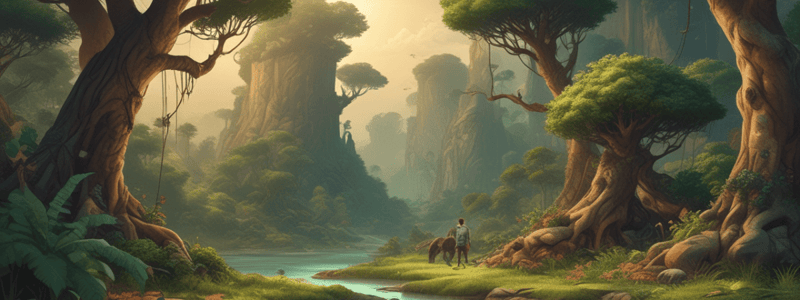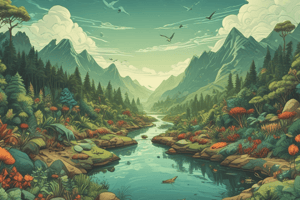Podcast
Questions and Answers
What is the term for the actual place an organism lives?
What is the term for the actual place an organism lives?
- Habitat (correct)
- Niche
- Microhabitat
- Microbiome
What is a small area within a larger habitat that supports a specific set of organisms?
What is a small area within a larger habitat that supports a specific set of organisms?
- Microbiome
- Habitat
- Niche
- Microhabitat (correct)
What is the term for the variety of environmental conditions within which a species can survive and reproduce?
What is the term for the variety of environmental conditions within which a species can survive and reproduce?
- Microbiome
- Tolerance (correct)
- Habitat
- Niche
What is the term that describes where an organism lives and what it does 'for a living'?
What is the term that describes where an organism lives and what it does 'for a living'?
What is the term for the microbial communities that inhabit places not typically considered habitats?
What is the term for the microbial communities that inhabit places not typically considered habitats?
What are the physical aspects of a species' niche?
What are the physical aspects of a species' niche?
What are the biological aspects of a species' niche?
What are the biological aspects of a species' niche?
What is the term for the range of physical and biological conditions in which a species can survive and reproduce?
What is the term for the range of physical and biological conditions in which a species can survive and reproduce?
What is the result of direct competition between two species according to the competitive exclusion principle?
What is the result of direct competition between two species according to the competitive exclusion principle?
What is the primary effect of competition on the species in a community?
What is the primary effect of competition on the species in a community?
What is the term for a single species that has a powerful influence on community structure?
What is the term for a single species that has a powerful influence on community structure?
What type of symbiosis is characterized by one organism living inside or on another organism and harming it?
What type of symbiosis is characterized by one organism living inside or on another organism and harming it?
What is the term for the series of somewhat predictable events that occur in a community over time?
What is the term for the series of somewhat predictable events that occur in a community over time?
What type of succession occurs when a disturbance affects an existing community but doesn’t completely destroy it?
What type of succession occurs when a disturbance affects an existing community but doesn’t completely destroy it?
What is the result of each species altering its environment in ways that make it easier for other species to compete for resources and survive?
What is the result of each species altering its environment in ways that make it easier for other species to compete for resources and survive?
What is the term for the first species to colonize barren areas?
What is the term for the first species to colonize barren areas?
What is the impact of predators on prey populations?
What is the impact of predators on prey populations?
What is the term for the interdependent relationship between two species?
What is the term for the interdependent relationship between two species?
What is the primary role of trees in an ecosystem?
What is the primary role of trees in an ecosystem?
What is the result of natural disturbances in healthy ecosystems?
What is the result of natural disturbances in healthy ecosystems?
What is the main difference between succession after natural disturbances and succession after human-caused disturbances?
What is the main difference between succession after natural disturbances and succession after human-caused disturbances?
What do ecologists study to understand patterns of succession?
What do ecologists study to understand patterns of succession?
Which type of biodiversity refers to the variety of habitats, communities, and ecological processes in the biosphere?
Which type of biodiversity refers to the variety of habitats, communities, and ecological processes in the biosphere?
What is genetic diversity?
What is genetic diversity?
What is one of the benefits of biodiversity in medicine?
What is one of the benefits of biodiversity in medicine?
What is the role of wild relatives in agriculture?
What is the role of wild relatives in agriculture?
What is ecosystem resilience?
What is ecosystem resilience?
What is one of the ecosystem services provided by diverse ecosystems?
What is one of the ecosystem services provided by diverse ecosystems?
Study Notes
Habitat and Niche
- Habitat: the actual place an organism lives, characterized by a specific combination of physical and biological environmental factors.
- Microhabitats: small areas within a larger habitat that support specific microorganisms.
- Microbiomes: microbial communities that inhabit unique environments and perform essential functions.
- Tolerance: the range of environmental conditions within which a species can survive and reproduce.
- Niche: describes where an organism lives and what it does, including its interactions with biotic and abiotic factors.
- Niche includes the physical and biological conditions necessary for survival and reproduction, as well as the resources it needs.
Resources
- Necessity of life: resources are essential for an organism's survival and reproduction.
- Physical aspects: abiotic factors such as light, temperature, and water that affect an organism's niche.
- Biological aspects: biotic factors such as food, predators, and competitors that influence an organism's niche.
Competition
- Competitive exclusion principle: direct competition between species often results in a winner and a loser, with the losing species dying out.
- Dividing resources: competition leads to specialization in resource acquisition and use, shaping the number and kinds of species in a community.
Predation and Herbivory
- Predator-prey relationships: predators can affect prey populations, influencing their behavior and distribution.
- Herbivore-plant relationships: herbivores impact plant populations, determining their size, distribution, and growth.
Keystone Species
- Keystone species: a single species with a significant influence on community structure, capable of altering the entire ecosystem.
Symbioses
- Interdependent relationships between two species: commensalism, mutualism, and parasitism.
- Commensalism: one species benefits, while the other is unaffected.
- Mutualism: both species benefit.
- Parasitism: one species benefits, while the other is harmed.
Succession
- Primary and secondary succession: ecological succession, a series of events that occur in a community over time.
- Primary succession: begins on newly formed rock or areas without remnants of an older community.
- Secondary succession: occurs when a disturbance affects an existing community but doesn't completely destroy it.
- Pioneer species: the first species to colonize barren areas.
- Why succession happens: each species alters its environment, making it easier for other species to compete and survive.
Climax Communities
- Succession after natural disturbances: can reproduce the original climax community.
- Succession after human-caused disturbances: may produce a different community.
- Studying patterns of succession: ecologists compare cases to identify similarities and differences.
Biodiversity, Ecosystems, and Resilience
- Types of biodiversity: community/ecosystem biodiversity, species diversity, and genetic diversity.
- Biodiversity benefits: contributes to medicine, agriculture, and ecosystem resilience.
- Biodiversity and medicine: many medicines were first discovered in wild species.
- Biodiversity and agriculture: wild relatives of crop plants may carry genes for disease resistance or other useful traits.
- Biodiversity and ecosystem resilience: affects ecosystem structure, stability, and function.
Ecosystem Services and Biodiversity
- Ecosystem services: benefits provided by ecosystems to humans, including food production, nutrient cycling, water purification, carbon storage, pest regulation, and pollination.
- Food production: diverse ecosystems provide resilient food sources.
- Nutrient cycling and soil structure: soil microbiomes maintain soil fertility and structure.
- Water purification: soil microbiomes, algae, and plants filter and purify fresh water.
- Carbon storage: healthy ecosystems remove carbon dioxide from the atmosphere and store it.
- Pest regulation: biologically diverse ecosystems include predators that feed on herbivores.
- Pollination: diverse ecosystems offer food and shelter to vital pollinators.
- Buffering effects of extreme weather events: diverse ecosystems protect against erosion and storms.
Studying That Suits You
Use AI to generate personalized quizzes and flashcards to suit your learning preferences.
Description
Understand the basics of habitats, niches, and species interactions in this biology quiz. Learn about the characteristics of a habitat and how it affects the organisms living in it.




